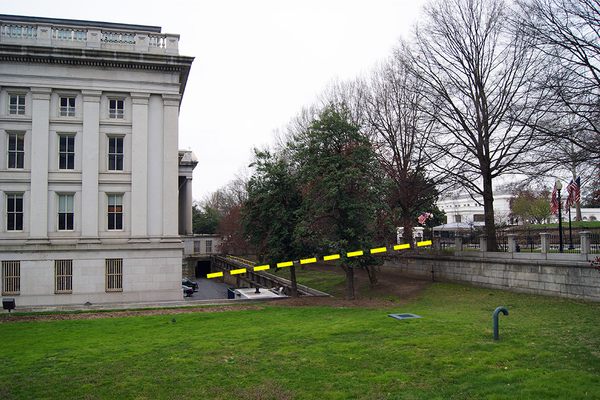How Judge Wapner Launched the Phenomenon of Court Shows on Modern TV
RIP Judge Wapner.
A version of this post originally appeared on Tedium, a twice-weekly newsletter that hunts for the end of the long tail.
Courtroom drama may be one of our greatest televised resources.
Reality-based shows that take place in a courtroom—of the actual kind, the high concept kind, and the heavily plotted kind—have proven one of the easiest ways to draw a consistent audience since television entered American lives in the 1950s.
Judge Joseph A. Wapner, who died on Sunday at the age of 97, started the trend, and defined it perhaps better than anyone. The longtime People’s Court judge spent 12 years calling balls and strikes in a courtroom that few physically walked into but many were familiar with.
And despite the fact that most of the cases did not reach the level of, say, constitutional law, he saw his role as incredibly important in its own way.
“The disputes are not really small,” Wapner explained in an interview with the Archive of American Television. “The amount of money might be small, but you could sue for a million dollars—because a million dollars are involved—but the same principles of law are involved there as with a case involving 75 cents.”
Yes, Wapner presided over a 75-cent case. The point at dispute? Whether or not a beer was flat.
“This man spent $6 to file the case, $14 to serve the papers—he’s spending $20 just to get his 75 cents back,” Wapner recalled of the case in 1986, which, like many People’s Court cases, was pulled from small claims courts in California’s legal system. “I ruled for the man with the beer.”
Warner, who served as a judge in the state of California prior to his television career, was not the first member of his family to appear on a court show: His father, Max Wapner, was a lawyer on the original (dramatized) version of Divorce Court, which aired from 1957 to 1962. (Yes, the original version of that show used actual lawyers.)
But of course, Wapner wasn’t the only star of this show, nor has he been the only host.
For example, longtime People’s Court host Doug Llewelyn lasted about as long as Wapner did, later replaced by TMZ founder Harvey Levin. Llewelyn, who oddly enough, also has some music video credits to his name—he was the announcer in Nirvana’s “In Bloom” video, and also starred in a Weird Al video—returned to the show in September.*
And then there is Wapner’s longtime bailiff, Rusty Burrell, who had a lot in common with his TV boss. Both had a longtime background in the California court system. Burrell was a bailiff on some high-profile cases, such as the trials of Charles Manson and Patty Hearst. Burrell often worked with Wapner—and also spent some time on Divorce Court.
Since Wapner’s departure, the show has since gone through a variety of hosts:
- Late New York City mayor Ed Koch hosted the show for two years in the late ‘90s, making him the only former People’s Court host to host Saturday Night Live … oh, and run a major city.
- Judge Judy’s husband, Jerry Sheindlin, hosted the show after Koch—which we’re assuming made for a weird couple of years in the Sheindlin household.
- Marilyn Milian, the current host of the show, has been on the air longer than Wapner has. She came up from the Florida court system, and had been appointed to her role by Janet Reno in the ‘90s. She may no longer be an actual judge, but she still has close ties to her former circuit—because, until earlier this year, her husband had her old job.
Of course, Judge Wapner set the form—not just for his show, but for every other one to come, scripted or not.
Wapner’s version of The People’s Court ended with its cancellation in 1993, or a year before the O.J. Simpson case, which was branded the Trial of the Century. And for a minute it looked like such gavel-to-gavel coverage of the court system might become a staple of American TV, but what has endured more powerfully instead is what Wapner started: television court shows, despite their lower stakes, perhaps in part because they were an early form of now-ubiquitous reality TV.
Why is that? A couple things: One, it’s a format everyone knows, and two, the shows are cheap to produce. Judge Joe Brown and Judge Alex can fill up a lot of airtime without requiring writers or paid actors. Even if their ratings suck, in other words, they still come out ahead.
And even big-name stars don’t push up the prices too much: It costs roughly $10 million to produce a season of Judge Judy, not factoring in the yearly salary of Judge Judy Sheindlin. Despite the judge’s massive salary, said to be $47 million per year, the show is a huge moneymaker for CBS Television, driving over $200 million in revenue yearly.
That potential for success is probably why “Ragin’ Cajun” James Carville attempted to get a court show of his own in 2014. It didn’t go through, but there is a glorious pilot online.
But there may be one other factor behind the success of court-based shows, whether in reality or dramatic format: You’re guaranteed conflict and resolution, which makes it perfect television.
Just don’t expect what shows up on the screen to match real life, however.
How far off is it? This was a question the American Bar Association covered at its 2014 annual meeting. A few key points touched upon during a panel discussion:
- In real life, there’s a lot less bending of the law than you think: University of Maryland law professor Taunya Lovell Banks suggests that ethics are a lot more important than many shows imply. “One of my biggest problems with a lot of the shows is that there are never any consequences when lawyers act in unethical ways,’’ Banks explained. “I find myself having to spend the first five minutes of my class—especially my first-year class—saying: ‘you cannot do this; if you do this you will lose your license.’”
- Good drama doesn’t make good law: Richard Sweren, a onetime criminal defense lawyer and noted writer for the Law and Order franchise, noted that, even with his legal background, he ultimately has to focus less on the law, and more on the plot. “I had to put my legal education, and ethical … all that aside,” he explained. “What makes the best drama? That’s what counts.”
- Legal dramas influence our perception of the courtroom: NYU Law School Senior Fellow Thane Rosenbaum, who moderated the panel, noted that the law often defines the way that we think of what happens in the justice system. It’s a little more complicated than that, however. “People want to believe that the law not only can provide moral outcomes but that it can discover the truth and that the truth is ultimately the most important thing,” Rosenbaum said.
Author Sarah Kozinn, in a 2015 book on the topic, suggested this problem of television courtrooms changing our perception of actual courtrooms was systemic.
“Like millions of Americans who have never set foot inside an actual courtroom, their first introductions to the legal process might well be through cultural representations of trials in plays, films, books, and television shows,” Kozinn wrote in Justice Performed: Courtroom TV Shows and the Theaters of Popular Law. “So, it is probable that a program like Judge Judy could constitute a substantial part of someone’s knowledge of the legal process.”
In any case, the somewhat convoluted setup of the court show makes it easy to mock the form.
During the final season of the first run of Arrested Development, in an episode produced at a point when the show’s creators knew the series was about to get canned, there was a pretty epic meta-commentary on court shows.
The actor Judge Reinhold got all diva-like about the name of the show—he didn’t want to be called a judge in the series—and there was a house band called William Hung and the Hung Jury.
It was one of the better gags in the series, and a great reminder that courtroom scenes in television shows aren’t actually like the real thing—no matter what Law and Order or Matlock might suggest.
*CORRECTION: This post originally omitted the fact that Llewelyn had returned to the show.
A version of this post originally appeared on Tedium, a twice-weekly newsletter that hunts for the end of the long tail.

















Follow us on Twitter to get the latest on the world's hidden wonders.
Like us on Facebook to get the latest on the world's hidden wonders.
Follow us on Twitter Like us on Facebook